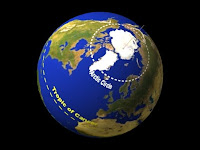 At the recent Copenhagen Climate Conference (COP15), Oceana was a visible presence with media presentations and staff on hand for interviews and discussions. While what seemed to captivate the press, and by extension the public, was whether a binding agreement could be achieved between the participating nations, what also was taking place at the conference was the dissemination of a lot of information concerning climate change and its related effects: ocean acidification, impacts on and from commercial fishing, changes within the Arctic circle, and so on.
At the recent Copenhagen Climate Conference (COP15), Oceana was a visible presence with media presentations and staff on hand for interviews and discussions. While what seemed to captivate the press, and by extension the public, was whether a binding agreement could be achieved between the participating nations, what also was taking place at the conference was the dissemination of a lot of information concerning climate change and its related effects: ocean acidification, impacts on and from commercial fishing, changes within the Arctic circle, and so on. All this information was being provided to insure that delegates from participating nations had the latest and most accurate information. Unfortunately, what was "sexier" to the press was the protests, bickering, and diplomatic machinations taking place, particularly as the conference moved into its second week and the question as to whether an agreement would be hammered out moved to center stage.
All this information was being provided to insure that delegates from participating nations had the latest and most accurate information. Unfortunately, what was "sexier" to the press was the protests, bickering, and diplomatic machinations taking place, particularly as the conference moved into its second week and the question as to whether an agreement would be hammered out moved to center stage.Oceana has assembled several videos that illustrate their presence at COP15. Blowing their own horn? Sure, but why not? Particularly since media coverage was focused elsewhere. Click here to view the videos.
One of the videos is an overview of the impact of climate change on the Arctic Circle, narrated by actor and staunch ocean conservationist, Ted Danson. I have seen some of the changes to the Arctic firsthand, working with InMER.org in the summer of 2007 when we conducted a
 reconnaissance of the Northwest Passage. Assisting expedition leader Ed Cassano, I documented, both on video/still images and through interviews with Inuit tribal elders and government officials, what has been taking place over the years.
reconnaissance of the Northwest Passage. Assisting expedition leader Ed Cassano, I documented, both on video/still images and through interviews with Inuit tribal elders and government officials, what has been taking place over the years.What at first appears to be desolate and formidable, the Arctic Circle is, in reality, a very vibrant but delicate ecosystem, the health of which having great implications for the rest of the planet. Several of the many warning signs we saw are subtle but alarming: shrinking summer sea ice,
 shrubbery and trees where there used to be only permafrost, the appearance of bees and other insects that had never been seen before - all are "canaries in the coal mine" that speak to bigger and more extensive worldwide changes in the near future.
shrubbery and trees where there used to be only permafrost, the appearance of bees and other insects that had never been seen before - all are "canaries in the coal mine" that speak to bigger and more extensive worldwide changes in the near future.In the informative application Google Earth (available at no charge; click here for details), throughout the area of the Northwest Passage (within the Arctic Circle, north of Canada), you can find several interesting pieces of visual/textual content supplied by InMER. I had the pleasure of producing several videos for this effort and would look forward to the opportunity to return to the Arctic again to further the cause for its protection.
The other videos on Oceana at Copenhagen center on interviews with dedicated staff members and scientists discussing issues ranging from ocean acidification to over-industrialization. One of the challenges in presenting these subjects in short form (IE: brief videos) is to arrive at a balance between presenting a simplified and oft-repeated message and providing technical information which can be lost on the viewer/listener. One of the videos, I thought, illustrated this balance well: an interview with Oceana science director Dr. Jeffrey Short who, with just a bit more information and an analogy or two, describes ocean acidification as something more than an obscure or academic concept for the average viewer.
Click here to view the videos.










No comments:
Post a Comment